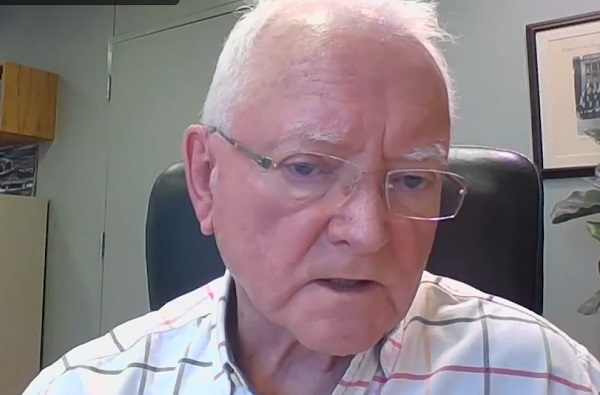2025 Federal Election
Mark Carney Says the Quiet Part Out Loud – Liberals Will Police ‘Wrong’ Speech Online


 Dan Knight
Dan Knight
The former central banker, who now postures as a man of the people, made it clear that if the Liberals are re-elected, the federal government will intensify efforts to regulate what Canadians are allowed to see, say, and share online.
At a campaign rally in Hamilton, Ontario, Liberal leader Mark Carney unveiled what can only be described as a coordinated assault on digital freedom in Canada. Behind the slogans, applause lines, and empty rhetoric about unity, one portion of Carney’s remarks stood out for its implications: a bold, unapologetic commitment to controlling online speech under the guise of “safety” and “misinformation.”
“We announced a series of measures with respect to online harm… a sea of misogyny, anti-Semitism, hatred, conspiracy theories—the sort of pollution that’s online that washes over our virtual borders from the United States.”
He then made clear his intention to act:
“My government, if we are elected, will be taking action on those American giants who come across [our] border.”
The former central banker, who now postures as a man of the people, made it clear that if the Liberals are re-elected, the federal government will intensify efforts to regulate what Canadians are allowed to see, say, and share online. His language was deliberate. Carney condemned what he called a “sea of misogyny, anti-Semitism, hatred, conspiracy theories” polluting Canada’s internet space—language borrowed directly from the Trudeau-era playbook. But this wasn’t just a moral denunciation. It was a legislative preview.
Carney spoke of a future Liberal government taking “action on those American giants who come across our borders.” Translation: he wants to bring Big Tech platforms under federal control, or at least force them to play the role of speech enforcers for the Canadian state. He blamed the United States for exporting “hate” into Canada, reinforcing the bizarre Liberal narrative that the greatest threat to national unity isn’t foreign actors like the CCP or radical Islamists—it’s Facebook memes and American podcasts.
But the most revealing moment came when Carney linked online speech directly to violence. He asserted that digital “pollution” affects how Canadians behave in real life, specifically pointing to conjugal violence, antisemitism, and drug abuse. This is how the ground is prepared for censorship: first by tying speech to harm, then by criminalizing what the state deems harmful.
What Carney didn’t say is just as important. He made no distinction between actual criminal incitement and political dissent. He offered no assurance that free expression—a right enshrined in Canada’s Charter of Rights and Freedoms—would be respected. He provided no definition of what constitutes a “conspiracy theory” or who gets to make that determination. Under this framework, any criticism of government policy, of global institutions, or of the new technocratic order could be flagged, throttled, and punished.
And that’s the point.
Mark Carney isn’t interested in dialogue. He wants obedience. He doesn’t trust Canadians to discern truth from fiction. He believes it’s the job of government—his government—to curate the national conversation, to protect citizens from wrongthink, to act as referee over what is and isn’t acceptable discourse. In short, he wants Ottawa to become the Ministry of Truth.
Why They Don’t Actually Care About Antisemitism
The Liberal establishment talks a big game about fighting hate—but when it comes to actual antisemitic violence, they’ve shown nothing but selective enforcement and political cowardice.
Let’s look at the facts.
In 2023, B’nai Brith Canada recorded nearly 6,000 antisemitic incidents, including 77 violent attacks—from firebombed synagogues to shots fired at Jewish schools in Montreal and Toronto. This wasn’t a marginal increase. It was a 208% spike in violent antisemitism in a single year.
Statistics Canada echoed the same alarm bells. Jews—who make up just 1% of Canada’s population—were the victims of 70% of all religiously motivated hate crimes. That’s nearly 900 recorded incidents, up 71% from the previous year. Then came October 2023, when Hamas launched its attack on Israel—and the wave of hate turned into a tsunami: a 670% increase in antisemitic incidents across the country. Jewish schools, synagogues, and community centers were hit with bomb threats, arson attempts, and intimidation campaigns. This was a national security issue, not just a policing matter.
And yet, the government’s response? Virtually nonexistent.
Case in point: the Montreal Riot, November 2024. A 600-person mob, waving anti-NATO and pro-Palestinian banners, turned violent—setting fires, smashing windows, and attacking police. Amid this chaos, a man was filmed screaming “Final Solution”—a direct reference to the Nazi plan to exterminate the Jews. It went viral. There was no ambiguity, no misunderstanding. It was a public call for genocide.
So what happened?
Three arrests. None for hate crimes. None related to antisemitism. Montreal Police Chief Fady Dagher insisted there were “no confirmed antisemitic acts,” and as of early 2025, no hate crime charges have been filed against the individual caught on camera.
That man, as it turns out, owned a Second Cup franchise. His punishment? His café was shut down by the company. Not by law enforcement. Not by hate crime investigators. A corporate HR department showed more backbone than Canada’s justice system.
And this is what reveals the truth: they don’t care. They’ll enforce hate speech laws when it’s politically convenient—when it can be used to silence critics, crush dissent, or placate woke constituencies. But when Jewish communities are being threatened, attacked, and terrorized? The same laws suddenly go limp. The same political class that claims to protect minorities becomes paralyzed. They won’t touch it. Because confronting real antisemitism would require standing up to their political allies in activist circles, university campuses, and radical protest movements.
This isn’t an accident. It’s a pattern.
The Liberals aren’t weak on antisemitism because they’re unaware of it. They’re weak on it because they don’t see political value in enforcing the law when it conflicts with their ideological allies. Their obsession isn’t with hate speech—it’s with controlling “wrong” speech. And what qualifies as “wrong” isn’t defined by law or principle. It’s defined by what the Liberal establishment deems unacceptable.
Their target isn’t violent bigotry. It’s dissent. They’ll chase down citizens for questioning carbon taxes or criticizing globalist policy—but when Jewish schools get shot at, or someone calls for genocide in the street, they shrug.
This isn’t leadership. It’s selective justice. And it proves, beyond any doubt, that their agenda was never about protecting Canadians. It was always about protecting control.
The Online Harms Act: Carney’s Blueprint for Speech Control
This isn’t hypothetical. Mark Carney’s remarks in Hamilton mirror the exact logic and intent behind the Online Harms Act (Bill C-63)—legislation drafted under the Liberal banner and introduced in 2024 that pushes Canada into territory no free society should accept.
At its core, Bill C-63 hands the federal government sweeping powers to police digital speech. It creates a Digital Safety Commission, an unelected bureaucratic authority empowered to monitor, investigate, and punish online platforms and individuals for content deemed “harmful.” That word—harmful—is never concretely defined. It includes things like “hate speech,” “conspiracy theories,” and vague notions of “harm to children,” but it’s written broadly enough to be used as a political weapon.
The most chilling provision? Preemptive imprisonment. Under this law, Canadians could be jailed for up to a year—without having committed a crime—if a judge believes they might post something harmful in the future. This isn’t law enforcement. This is thought policing.
Carney didn’t just echo this approach—he amplified it. In his Hamilton rally, he described the internet as being flooded with “misogyny, anti-Semitism, hatred, conspiracy theories,” and laid blame on foreign content “washing over our borders from the United States.” He didn’t argue for open debate or for empowering users to challenge dangerous ideas. He argued for the state to intervene and shut them down.
He told Canadians that these ideas are “changing how people behave” and claimed his government will go after “those American giants” that allow this content to circulate. There’s no ambiguity here: this is a public declaration that a Liberal government under Mark Carney intends to censor, de-platform, and penalize dissenting views. Not illegal ones—just ones they don’t like.
And this isn’t new for him. Back in 2022, during the Freedom Convoy, Carney referred to protesters as committing “sedition” and demanded the government “thoroughly punish” them. These weren’t violent rioters or foreign agitators—these were working-class Canadians honking their horns and standing in the cold, protesting vaccine mandates. For Carney, their real crime was disobedience.
Carney’s view of speech is simple: if it challenges the ruling order, it’s dangerous. And now, with Bill C-63 on the table and Carney at the helm, he’s building the legal infrastructure to lock down the digital public square—not to protect Canadians from violence, but to protect the Liberal establishment from criticism.
That law is real. Carney’s agenda is real. And if he wins, enforcement is coming.
Final thoughts
This is the Canada Mark Carney envisions—one where citizens can’t speak freely online without first checking their views against government guidelines. A country where speech is no longer a right but a privilege granted by bureaucrats. A country where opposition isn’t argued with, it’s labeled harmful and erased.
There was a time when Liberals championed civil liberties. That era is over. The new Liberalism is authoritarian—cloaked in the language of safety and inclusion, but animated by control. Carney’s rally in Hamilton wasn’t a policy rollout. It was a warning to anyone who still thinks they live in a country where dissent is allowed.
They don’t want to fight hate. They want to define “wrong” speech—and then eliminate it. And by “wrong,” they mean anything the Liberal establishment disapproves of. Criticize the government, question the orthodoxy, challenge the state’s narrative, and you’ll be branded a threat. Not a citizen. Not a participant. A threat.
So here we are.
The speech laws are written. The censors are waiting. And Mark Carney is ready to pull the trigger.
This election isn’t about tax credits or campaign slogans. It’s about whether Canada remains a free country or slides deeper into soft tyranny, one regulation, one commission, one silenced voice at a time.
There is a choice. And the choice is this: bring it home—restore freedom, restore sanity, restore this country.
Or: hand the keys to the same people who think you’re the problem for having the nerve to think for yourself.
Subscribe to The Opposition with Dan Knight .
For the full experience, upgrade your subscription.
2025 Federal Election
I don’t believe these polls!

 Dan McTeague
Dan McTeague
Cards on the table, I’m skeptical of the current state of the polling in this election. My sense is that Mark Carney and the Liberals’ numbers are, at least in part, a byproduct of sympathetic pollsters over-sampling their key demographics, and those being trumpeted to high heaven by the publicly-funded media. That, coupled with voters’ justifiable annoyance at Donald Trump’s “51st State” cracks and tariff threats, has contributed to an illusion of enthusiasm, a sense that they are running away with this thing.
That said, one polling data point has struck me as being both real and important. A recent Abacus Data poll showed that, when you cut out all the distractions, Canadians’ biggest concern remains our inflated cost of living. And that is an issue which clearly favors Poilievre and the Conservatives.
That’s because the dire state of our economy can largely be laid at the feet of the Liberals, who’ve been running the show for the past decade. Yes, they’ve made a change at the top, but not much of one. On top of being a globe-trotting member of the “Green” Elite, and champion of environmentalist banking, Mark Carney was a Liberal advisor for years, a key part of the Trudeau “brain trust” — trust me, I use that term loosely — that cooked up a whole raft of economy smothering “Green” policies which have done nothing to reduce global carbon emissions, but have succeeded in lightening our wallets.
Under Trudeau, our annual GDP growth noticeably shifted from the 3% range towards the end of the Harper years to the 1% range more recently. Household debt-to-income ratios rose steadily in the same period, while real household spending per capita dropped 2-3% below 2019 levels by 2024, as costs and interest rates went up. Disposable income growth has been outpaced by inflation and taxes, and bankruptcy filings have risen 40% since just 2019.
Canadian food prices have exploded by 35-40%, with family spending up over 50% over the past decade. Consequently, food insecurity rose to 23% by 2023, from around 8% in 2015, and Food Banks Canada has reported a 78% surge in usage from 2019 to 2023.
Meanwhile, Canada’s national debt, which was just over $600 billion when Justin Trudeau was handed the federal credit card, has roughly doubled, reaching over $1.2 trillion by the time he left. And provincial debt has risen by about $1 trillion in the same period.
It’s a frightening financial snapshot. And many of these negatives can be attributed to the Liberals’ war on oil and gas, which remains — however much Carney might wish otherwise — the backbone of our national economy.
So much of the Liberals’ time and effort in government has been spent kneecapping the resource sector, and for purely ideological reasons. From Bill C-48, the Oil Tanker Moratorium Act of 2019, which significantly reduces our ability to sell oil and gas abroad, to Bill C-69, which added mountains of red tape for infrastructure projects, so much so that it was nicknamed the “No More Pipelines” Act.
You’ll remember that the Supreme Court ruled the “No More Pipelines” act largely unconstitutional two years ago. Even so, Carney recently said he has no intention of repealing it, prompting Poilievre to tweet out, “This Liberal law blocked BILLIONS of dollars of investment in oil & gas projects, pipelines, LNG plants, mines, and so much more,” with an excellent infographic attached, listing the various cancelled energy projects throughout Canada since the Liberals came to power.
And then of course, there’s the Consumer Carbon Tax, which started out at $20 per tonne of CO2 emitted in 2019, small enough that many Canadians barely noticed they were paying it, but increased every year until it hit $80 per tonne.
By that point it became so noticeable and unpopular that the Liberals felt they had no choice but to “cancel” it (“zero it out” is more accurate), before it could reach the $170 by 2030 which they’d planned. Still, it remains on the books, ready to be raised again, without a vote, if Carney so chooses.
Even if he doesn’t, Carney has doubled down on the Industrial Carbon Tax. While the Liberals claim this is an improvement because it isn’t paid by working Canadians, only by big evil “polluters.” Of course, they said something similar about the Consumer Tax, that by some financial wizardry, we regular folks would get back more than we paid in, which turned out to be total bunk.
Meanwhile, the Industrial Tax makes our lives more expensive in essentially the same way as the Consumer Tax. It raises the cost of doing business, of heating our homes, of filling up our car, of our grocery bills. It just does so by a less direct route, by taxing businesses instead of individuals, so that we pay when the price of goods and services goes up in response.
The Industrial Carbon Tax, much like Trudeau’s Clean Fuel Regulations, is ultimately a hidden tax, and that suits Carney just fine. He’d prefer that we not know who to blame as our cost of living skyrockets.
The Liberal Party’s economic record over since 2015 has been atrocious, and it will be no different under Mark Carney. He is complicit, and he continues to support policies which would make us poorer, like Bill S-243, the “Climate-Aligned Finance Act,” which Carney testified before the Senate in support of last year. That bill sought to make it nearly impossible for banks to invest in, or loan money to, oil and gas projects in Canada, and tried to force financial institutions to appoint board members ideologically opposed to fossil fuels.
Canada needs to change course, and soon. As things stand, it will be tough for even a good captain to navigate us through the rough seas the Liberals have steered us into over the past ten years. A few more, and with Mark Carney at the helm, might make that impossible.
Dan McTeague is President of Canadians for Affordable Energy.
Support Dan’s Work to Keep Canadian Energy Affordable!
Canadians for Affordable Energy is run by Dan McTeague, former MP and founder of Gas Wizard. We stand up and fight for more affordable energy.
2025 Federal Election
Don’t double-down on net zero again

From the Fraser Institute
In the preamble to the Paris Agreement, world leaders loftily declared they would keep temperature rises “well below 2°C” and perhaps even under 1.5°C. That was never on the cards—it would have required the world’s economies to effectively come to a grinding halt.
The truth is that the “net zero” green agenda, based on massive subsidies and expensive legislation, will likely cost more than CAD$38 trillion per year across the century, making it utterly unattractive to voters in almost every nation on Earth.
When President Trump withdrew the United States from the Paris Climate Agreement for the first time in 2017, then-Canadian Prime Minister Justin Trudeau was quick to claim the moral high ground, declaring that “we will continue to work with our domestic and international partners to drive progress on one of the greatest challenges we face as a world.”
Trudeau has now been swept from the stage. On his first day back in office, President Trump signed an executive order that again begins the formal, twelve-month-long process of withdrawing the United States from the Paris Agreement.
It will be tempting for Canada to step anew into the void left by the United States. But if the goal is to make effective climate policy, whoever is Canada’s prime minister needs to avoid empty virtue signaling. It would be easy for Canada to declare again that it’ll form a “coalition of the willing” with Europe. The truth is that, just like last time, that approach would do next to nothing for the planet.
Climate summits have generated vast amounts of attention and breathless reporting giving the impression that they are crucial to the planet’s survival. Scratch the surface, and the results are far less impressive. In 2021, the world promised to phase-down coal. Since then, global coal consumption has only gone up. Virtually every summit has promised to cut emissions but they’ve increased almost every single year, and 2024 reached a new high.
Way before the Paris Agreement was inked, the Kyoto Protocol was once sold as a key part of the solution to global warming. Yet studies show it achieved virtually nothing for climate change.
In the preamble to the Paris Agreement, world leaders loftily declared they would keep temperature rises “well below 2°C” and perhaps even under 1.5°C. That was never on the cards—it would have required the world’s economies to effectively come to a grinding halt.
The truth is that the “net zero” green agenda, based on massive subsidies and expensive legislation, will likely cost more than CAD$38 trillion per year across the century, making it utterly unattractive to voters in almost every nation on Earth.
The awkward reality is that emissions from Canada, the EU, and other countries pursuing climate policies matter little in the 21st century. Canada likely only makes up about 1.5 per cent of the world’s emissions. Add together Canada’s output with that of every single country of the rich-world OECD, and this only makes up about one-fifth of global emissions this century, using the United Nations’ ‘middle of the road’ forecast. The other four-fifths of emissions come mostly from China, India and Africa.
Even if wealthy countries like Canada impoverish themselves, the result is tiny — run the UN’s standard climate model with and without Canada going net-zero in 2050, and the difference is immeasurable even in 2100. Moreover, much of the production and emissions just move to the Global South—and even less is achieved.

One good example of this is the United Kingdom, which—like Prime Minister Trudeau once did—has leaned into climate policies, suggesting it would lead the efforts for strong climate agreements. British families are paying a heavy price for their government going farther than almost any other in pursuing the climate agenda: just the inflation-adjusted electricity price, weighted across households and industry, has tripled from 2003 to 2023, mostly because of climate policies. This need not have been so: the US electricity price has remained almost unchanged over the same period.
The effect on families is devastating. Had prices stayed at 2003 levels, an average family-of-four would now be spending CAD$3,380 on electricity—which includes indirect industry costs. Instead, it now pays $9,740 per year.
Rising electricity costs make investment less attractive: European businesses pay triple US electricity costs, and nearly two-thirds of European companies say energy prices are now a major impediment to investment.
The Paris Treaty approach is fundamentally flawed. Carbon emissions continue to grow because cheap, reliable power, mostly from fossil fuels, drives economic growth. Wealthy countries like Canada, the US, and European Union members have started to cut emissions—often by shifting production elsewhere—but the rest of the world remains focused on eradicating poverty.
Poor countries will rightly reject making carbon cuts unless there is a huge flow of “climate aid” from rich nations, and want trillions of US dollars per year. That won’t happen. The new US government will not pay, and the other rich countries cannot foot the bill alone.
Without these huge transfers of wealth, China, India and many other developing countries will disavow expensive climate policies, too. This potentially leaves a rag-tag group led by a few Western European progressive nations, which can scarcely afford their own policies and have no ability to pay off everyone else.
When the United States withdrew from the Paris Agreement in 2017, Canada’s doubling down on the Paris Treaty sent the signal that it would be worthwhile spending hundreds of trillions of dollars to make no real difference to temperatures. We fool ourselves if we pretend that doing so for a second time will help the planet.
We need to realize that fixing climate change isn’t about sanctimonious summits, lofty speeches, and bluster. In coming weeks I’ll outline the case for efficient policies like innovation, adaptation and prosperity.
-

 2025 Federal Election13 hours ago
2025 Federal Election13 hours agoLiberals Replace Candidate Embroiled in Election Interference Scandal with Board Member of School Flagged in Canada’s Election Interference Inquiry
-

 Alberta12 hours ago
Alberta12 hours agoIs Canada’s Federation Fair?
-

 Alberta11 hours ago
Alberta11 hours agoProvince introducing “Patient-Focused Funding Model” to fund acute care in Alberta
-

 espionage14 hours ago
espionage14 hours agoU.S. Experts Warn Canada Is Losing the Fight Against PRC Criminal Networks—Washington Has Run Out of Patience
-

 Alberta7 hours ago
Alberta7 hours agoMedical regulator stops short of revoking license of Alberta doctor skeptic of COVID vaccine
-

 Automotive15 hours ago
Automotive15 hours agoTesla Vandals Keep Running Into The Same Problem … Cameras
-

 International8 hours ago
International8 hours agoUN committee urges Canada to repeal euthanasia for non-terminally ill patients
-

 COVID-1950 mins ago
COVID-1950 mins agoMassive new study links COVID jabs to higher risk of myocarditis, stroke, artery disease




